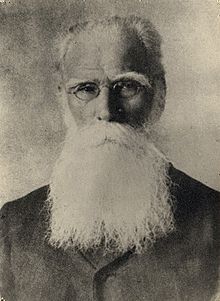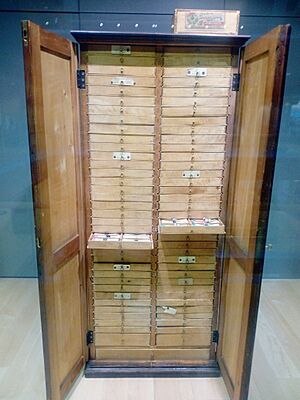Krišjānis Barons facts for kids
Quick facts for kids
Krišjānis Barons
|
|
|---|---|

Krišjānis Barons in 1910
|
|
| Born | October 31, 1835 Jaunpils parish, Russian Empire |
| Died | March 8, 1923 (aged 87) Rīga, Latvia |
| Occupation | Writer folklorist linguist |
| Literary movement | Young Latvians |
| Spouse | Dārta Barons |
Krišjānis Barons was a famous Latvian writer. He lived from October 31, 1835, to March 8, 1923. People often call him the "father of the dainas" (Latvian: "Dainu tēvs"). This is because he collected and organized many Latvian folk songs. He helped publish them in a huge book called Latvju dainas. His face was even on the 100-lat banknote. This was before Latvia started using the Euro in 2014. He was the only real person on modern Latvian money! Barons was also a key member of the Young Latvians group. He was an important writer and editor.
Contents
The Latvju Dainas Collection
What are Latvju Dainas?
Krišjānis Barons is well known for creating Latvju dainas (LD). This huge collection was published in six books between 1894 and 1915. It includes an amazing 217,996 folk songs!
Many people think Barons wrote all these songs or collected them himself. But that's not quite right. He didn't come up with the first idea for the collection. He also didn't collect all the tiny paper slips for the famous Cabinet of Folksongs (Dainu skapis). However, he did write on many of these slips himself.
His work was still incredibly important. Barons created the system to sort all the songs. He arranged them and grouped similar songs together. This made it easier to read and saved space in the books. He also fixed some song texts. He wanted to make them sound like their oldest and best versions.
In 2001, the UNESCO Memory of the World Register added Barons' work and the Cabinet of Folksongs. This shows how valuable his efforts and this collection are.
How the Songs Were Collected
Even when Barons was working, traditional singing was becoming less common. Barons wrote that the "sources of nation's memory... started to flow amazingly." He also worried that "the old ladies, our purest source of folk songs, become rarer and rarer." He noted that Latvians sometimes stopped singing traditional songs, for example, when they became Christians.
Publishing the Collection
Krišjānis Barons was not the only person listed on the title page of Latvju dainas. Henrijs Visendorfs (1861–1916) was also named. Barons wrote that in 1892, Visendorfs offered to help publish the books. They quickly agreed to work together.
Visendorfs was a wealthy Latvian merchant in St. Petersburg. He was interested in Latvian culture and supported researchers. He also wrote about Latvian mythology. Visendorfs later gave Barons copies of song collections. These came from the Jelgava Latvian Society.
By the time the first book of LD was published, Visendorfs had given Barons 12,800 song texts. He got these from local collectors. His full collection had 28,406 texts. Visendorfs likely suggested the word "daina" for the title. This word is actually Lithuanian.
Visendorfs paid for the first book himself. But it was very expensive. So, he used his connections to get the Imperial Academy of Sciences to publish the other books. This was officially agreed upon in 1900. From 1903 to 1915, the rest of the books were published. These later books had title pages in Latvian, French, and Russian.
Visendorfs didn't edit the songs, but his help was still very important. He organized things, checked the printed pages, and gave advice. That's why his name is on the title page.
In 1893, Krišjānis Barons returned to Latvia with his Cabinet of Folksongs. At that time, it held about 150,000 texts. The index for LD shows over 900 people helped. This included 237 male and 137 female informants (people who shared songs). There were also 54 regular people who collected songs, at least 150 school teachers, 50 writers, and 20 priests.
Barons said that 217,996 texts were used in total. This is the number usually given for the published songs. However, the collection didn't cover all of Latvia. About 218 Latvian parishes (local areas) didn't have even one song. So, 30 years after LD was started, a new group called Latviesu folkloras krātuve began collecting from these areas.
Latvju dainas is the most famous and quoted collection of Latvian folk songs. It has been reprinted twice, in 1922–1923 and 1989–1994.
Krišjānis Barons' Legacy

Barons' work in collecting folklore and dainas was very important. It helped create Dievturība. This was a Baltic neopagan movement started by Ernests Brastiņš and Kārlis Marovskis-Bregžis in the 1920s.
A minor planet (a small space rock) is named after him. It's called 3233 Krišbarons. Soviet astronomer Nikolai Stepanovich Chernykh discovered it in 1977. Also, one of the main streets in Riga, Latvia, is named after him: Krišjāna Barona iela.
His family members live in the United States today. Most of them are in a small town in western Pennsylvania called Grove City.
See also
 In Spanish: Krišjānis Barons para niños
In Spanish: Krišjānis Barons para niños


